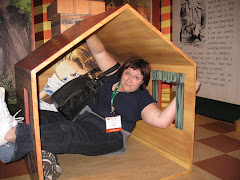During the development of Dinosphere, here at The Children's Museum of Indianapolis, immersive was the buzzword of the day. Now, usually a "buzzword" is a bad thing, but really, the word is completely appropriate for what was created. The exhibit IS immersive and is very effective. Usually when we talk about immersive exhibits, we talk about the elements that engage the senses. Dinosphere uses dramatic lighting and projection (sight), amazing audio (sound), the scents of magnolia blossom and dung (smell), and hands-on casts (touch) to create this environment. But a truly immersive environment - and indeed this one - is more than the sum of its parts.
When you step into Dinosphere (and I do believe I am not being completely biased here - just slightly) you are met with a feeling of being taken away from the rest of the museum. You know you aren't in the Late Cretaceous, because, well, those Dinos wouldnt be just bones, would they. Nor would there be as many strollers. But you feel elsewhere. Even with the crowds and the children and the fact that you know you are in a museum, for just a moment, you are able to lose yourself in the exhibit.
So, why did my trip to AZ trigger this? The two aforementioned exhibits each had a moment of transporting the visitor elsewhere, but in very different ways.
The Narnia exhibit has one of the best "reveals" of an exhibit I have seen so far. I think the only show I have seen recently that comes close is Real Pirates. The queue space is dressed out as CS Lewis' study, with additional photos/posters/etc that explain (kind of) the practice of sending British children to the country during WWII. The design starts with a lion motif there, with some great propoganda posters showing a regal lion to represent Britain. There were also amazing artifacts, which I fear would be overlooked with a packed queue. Among the artifacts were the actual wardrobe from Lewis' office that inspired the book, as well as letters, a journal and a desk.
The group is gathered into the orientation theater - a wonderfully recreated Spare Oom. The exhibit geek in me was particularly taken by the rubber floor that looked like an old hardwood floor. The orientation theater didnt show a film, but rather had an audio track, narrated I believe by Lewis' stepson, and some environmental bits - rain at the windows (because it was a rainy day) and dim lighting. At the moment of the reveal, the spots came up on the wardrobe doors and they opened, revealing a passage lined with fur coats and a beautiful wintry scene. And it was snowing on me. Amazing! There I was, by the lamp post, with a backdrop of snowy trees, with flakes coming down on me.
For a few moments, I was Susan (always did identify with the one not allowed back into Narnia more) stepping into Narnia for the first time. I was completely transported in that one area. Now, I'll probably have more at some point about the rest of the exhibit, but for now, know that the reveal is tremendous, and that you really do feel there, if only for a moment.
 A contrast to this is AZScience's Forces of Nature exhibit. Narnia, like Dinosphere, takes a page from classic theatrical sets and immersive theme park settings, complete with foliage and faux rocks. In Forces of Nature, all you get is a metal platform, 4 large screens and an assortment of fixtures hanging above.
A contrast to this is AZScience's Forces of Nature exhibit. Narnia, like Dinosphere, takes a page from classic theatrical sets and immersive theme park settings, complete with foliage and faux rocks. In Forces of Nature, all you get is a metal platform, 4 large screens and an assortment of fixtures hanging above.The theater was amazing! The show was a few minutes long (I honestly don't know because when I tried to time it I kept getting distracted by the awesomeness) and runs through various earth events - from lightning strikes to hurricanes to forest fires. The above fixtures provide light, sound, wind, rain and heat to let you experience these forces.
The show begins with a beautiful video of lightning strikes complemented by flashes of lights and rumbles from the floor. The segment ends with a dramatic shot of a tree being struck, coupled with a bright flash and a "CRACK!" along with a big shake of the floor. And all the children around screamed. Then we move into forest fires - as the heat lamps all around raged, and everyone clustered to the middle of the platform to escape the heat. Then a tornado, an earthquake, a hurricane with "rain", a dust storm, monsoon....
It was amazing. The visitors were so into it, and were transported. It didnt matter that they were just standing on a platform in a busy gallery. There was nothing that blocked the rest of the exhibit from view. But when that hurricane started, the adults pulled their kids closer. When the fires raged, people moved away. It was wonderful.
Both exhibits did this well. Both transported you. Others have done too. But the Forces one impressed me most because it did it without building a huge display or theater, and trusted in the power of the experience, rather than the set dressing.






